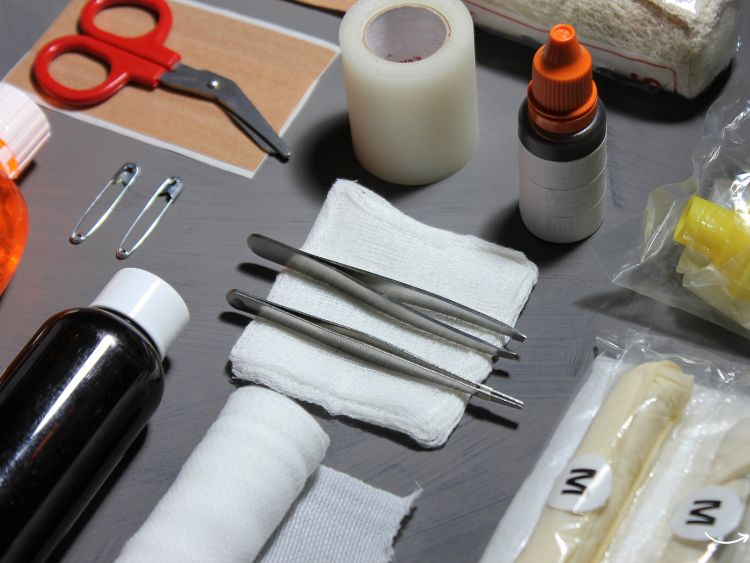When you hit the road, you’re prepared for just about anything—flat tires, empty gas tanks, or maybe even an unexpected detour. But what about those unforeseen health emergencies? That’s where a well-stocked car first aid kit comes in handy. Whether you’re driving across town or embarking on a cross-country road trip, having a car first aid kit is not just a smart idea—it’s a necessity.
Why a Car First Aid Kit is Essential
You might be thinking, “I’m a careful driver; what could possibly go wrong?” But the truth is, accidents and medical emergencies can happen to anyone, anywhere, and at any time. A car first aid kit equips you to handle minor injuries on the spot, preventing them from becoming major issues. It’s peace of mind in a box—a small investment that pays off big when the unexpected occurs.
What Should Be in a Car First Aid Kit?
Now that you know why a car first aid kit is essential, the next question is, what should it contain? Here’s a comprehensive list of items every car first aid kit should have:
- Bandages and Gauze:
- Adhesive bandages of various sizes
- Sterile gauze pads
- Adhesive tape
- Antiseptic Wipes and Ointment:
- Antiseptic wipes for cleaning wounds
- Antibiotic ointment to prevent infection
- Tools:
- Scissors
- Tweezers
- A digital thermometer
- Medications:
- Pain relievers (like ibuprofen or aspirin)
- Antihistamines for allergic reactions
- Hydrocortisone cream for itching and rashes
- Emergency Items:
- A space blanket for warmth
- Instant cold packs for sprains or bruises
- A CPR mask
- Personal Items:
- Any prescription medications you or your family members might need
- A list of emergency contacts
- A small flashlight with extra batteries
How to Choose the Best Car First Aid Kit
Not all car first aid kits are created equal. When selecting one, consider the following factors:
- Size and Portability: The kit should be compact enough to store in your car but large enough to carry all the necessary items.
- Contents: Ensure the kit includes everything you might need in an emergency. It’s better to have a few extra items than to find yourself lacking in a critical moment.
- Durability: The container should be sturdy and waterproof to protect its contents from damage.
- Ease of Use: The items should be organized and labeled clearly so you can find what you need quickly in an emergency.
Customizing Your Car First Aid Kit
One size doesn’t fit all, especially when it comes to first aid. While pre-made kits are convenient, they may not meet all your specific needs. Here’s how you can customize your car first aid kit:
- Consider Your Location: If you often travel through remote areas, include additional survival items like water purification tablets or a whistle.
- Family Needs: Tailor the kit to your family’s needs. If you have young children, add items like children’s pain relievers and adhesive bandages with fun designs.
- Seasonal Adjustments: Depending on the time of year, you might need to add items like sunscreen in the summer or hand warmers in the winter.
Keeping Your Car First Aid Kit Up to Date
Once you have a car first aid kit, it’s not a set-it-and-forget-it situation. You need to maintain it regularly to ensure it’s always ready when you need it. Here are a few tips:
- Check Expiration Dates: Medications and some first aid items have expiration dates. Regularly check these and replace any expired items.
- Restock After Use: If you use any items from the kit, replace them as soon as possible.
- Seasonal Checks: At the start of each season, review your kit and adjust its contents as needed.
Where to Store Your Car First Aid Kit
The best place to store your car first aid kit is in an easily accessible location. The glove compartment is a common choice, but if your kit is larger, you might need to store it in the trunk. Wherever you decide to keep it, make sure everyone who uses the car knows where it is and how to access it quickly.
Common Scenarios Where a Car First Aid Kit is Crucial
Here are a few scenarios where having a car first aid kit can make a significant difference:
- Minor Cuts and Scrapes: Whether it’s a scraped knee from a roadside picnic or a minor cut from changing a tire, having bandages and antiseptic wipes on hand allows you to clean and cover the wound quickly, reducing the risk of infection.
- Burns: Accidents like spilling hot coffee or touching a hot engine part can lead to minor burns. Your first aid kit should have burn cream or aloe vera to soothe the skin.
- Allergic Reactions: If someone in the car has an allergic reaction, quick access to antihistamines can be lifesaving.
- Sprains and Strains: If someone twists an ankle while hiking or during a roadside stretch, an instant cold pack and elastic bandage can help reduce swelling and provide support until further treatment is available.
FAQs About Car First Aid Kits
Q: How often should I check my car first aid kit?
A: You should check your car first aid kit every six months. Replace expired items and restock any supplies that have been used.
Q: Can I buy a pre-made car first aid kit?
A: Yes, pre-made kits are available and can be very convenient. However, you may want to customize them to better suit your needs.
Q: What should I do if someone is seriously injured?
A: If someone is seriously injured, the first step is to call emergency services. Your car first aid kit can help you manage the situation until help arrives, but it’s not a substitute for professional medical care.
Q: Should I include personal medications in my car first aid kit?
A: Yes, it’s a good idea to include any prescription medications that you or your passengers might need in an emergency.
Q: Can I use items from my car first aid kit for pets?
A: Some items, like bandages and antiseptic wipes, can be used for pets. However, always consult your vet before using medications or treatments intended for humans on animals.
Summary
A car first aid kit is a crucial component of vehicle safety. It ensures you’re prepared for minor injuries and medical emergencies, giving you peace of mind during every journey. By customizing your kit, keeping it up to date, and storing it in an accessible location, you can handle unexpected situations with confidence. Remember, it’s better to have a car first aid kit and not need it than to need it and not have it.
Authoritative Links:







